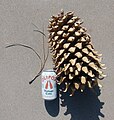Coulter pine
Appearance
| Coulter pine Pinus coulteri | |
|---|---|

| |
| A Pinus coulteri seed cone at Mount Wilson, California | |
| Scientific classification | |
| Kingdom: | Plantae |
| Clade: | Tracheophytes |
| Clade: | Gymnospermae |
| Division: | Pinophyta |
| Class: | Pinopsida |
| Order: | Pinales |
| Family: | Pinaceae |
| Genus: | Pinus |
| Subgenus: | P. subg. Pinus
|
| Section: | P. sect. Trifoliae
|
| Subsection: | P. subsect. Ponderosae
|
| Species: | P. coulteri
|
| Binomial name | |
| Pinus coulteri D. Don | |

| |
| Natural range | |
Coulter pine (Pinus coulteri), or big-cone pine, is a native of the coastal mountains of
botanist and physician. The Coulter pine produces some of the heaviest cones of any pine tree, up to 5 kg (11 lb) and among conifers is exceeded only by the cones of Araucaria bidwillii
.
Although it has a limited range in the wild, the Coulter pine is a popular
ornamental tree
and is grown in many countries.
Description
Pinus coulteri is a substantial
Pinus. The size ranges from 10–24 m (33–79 ft) tall,[2] and a trunk diameter up to 1 m (3.3 ft). The trunk is vertical and branches horizontal to upcurved. The leaves
are needle-like, in bundles of three, glaucous gray-green, 15–30 cm (5.9–11.8 in) long and stout, 2 mm (0.079 in) thick.
The outstanding characteristic of this tree is the large, spiny
sugar pine
are longer. The large size of the cones, combined with the claw-like scales, has earned them the nickname "widowmakers" among locals.
Ecology
The Coulter pine is closely related to the
ponderosa pine.[5]
Coulter pines tend to grow in drier environments than ponderosa and Jeffery pines.
This erect, medium-sized
California black oak.[6] Woodpeckers often forage on the species, and peel the bark to access insects underneath.[7]
Uses
Wildlife, especially squirrels, gather the large seeds. They were also once eaten by Native Americans.[8]
The wood is weak and soft, so that the species is little used other than for firewood.
Pinus coulteri is cultivated as an
ornamental tree, planted in parks and large gardens, and drought tolerant landscaping. The Coulter pine has gained the Royal Horticultural Society's Award of Garden Merit.[9]
Gallery
-
Pollen cones (male cones)
-
Mature tree, as seen from under branches at ground level
-
Close-up of bark detail
-
Foliage and cones
-
Cones on ground in their natural setting
-
Large cone, found at 4,150 ft elevation in the Santa Lucia Ranger District of theCentral Coast.
-
Exceptional cone example, shown with needle cluster (soda can for scale).
-
Cone
-
Close-up of spiral detail
-
Close-up of barb detail
-
Seeds
-
A view of the upper portion of a mature Coulter Pine.
References
- ^ Farjon 2013.
- ^ Earle 2018.
- ^ Lanner, Ronald M. (1999). Conifers of California. Los Olivos, California: Cachuma Press. pp. 73–74.
- ^ Gardener's Chronicle Volume 23 (third series)(March 28, 1885) Page 415
- ^ Cope 1993.
- ^ Hogan 2008.
- ^ NWF Field Guide.
- ISBN 0-394-73127-1.
- ^ RHS Gardening.
Bibliography
- OCLC 3477527.
- Cope, Amy B. (1993). "Pinus coulteri". Fire Effects Information System (FEIS). US Department of Agriculture (USDA), Forest Service (USFS), Rocky Mountain Research Station, Fire Sciences Laboratory.
- Earle, Christopher J., ed. (2018). "Pinus coulteri". The Gymnosperm Database.
- Farjon, A. (2013). "Pinus coulteri". .
- Kral, Robert (1993). "Pinus coulteri". In Flora of North America Editorial Committee (ed.). Flora of North America North of Mexico (FNA). Vol. 2. New York and Oxford: Oxford University Press – via eFloras.org, Missouri Botanical Garden, St. Louis, MO & Harvard University Herbaria, Cambridge, MA.
- Hogan, C. Michael (2008). Stromberg, Nicklas (ed.). "Pinus coulteri". Globaltwitcher.com. Archived from the original on 2012-02-18.
- Moore, Gerry; Kershner, Bruce; Tufts, Craig; Mathews, Daniel; ISBN 978-1-4027-3875-3.
- "Pinus coulteri". RHS Gardening. Royal Horticultural Society. Retrieved 2013-09-27.[permanent dead link]
External links
Wikimedia Commons has media related to Pinus coulteri
(Coulter pine).
(Coulter pine).














